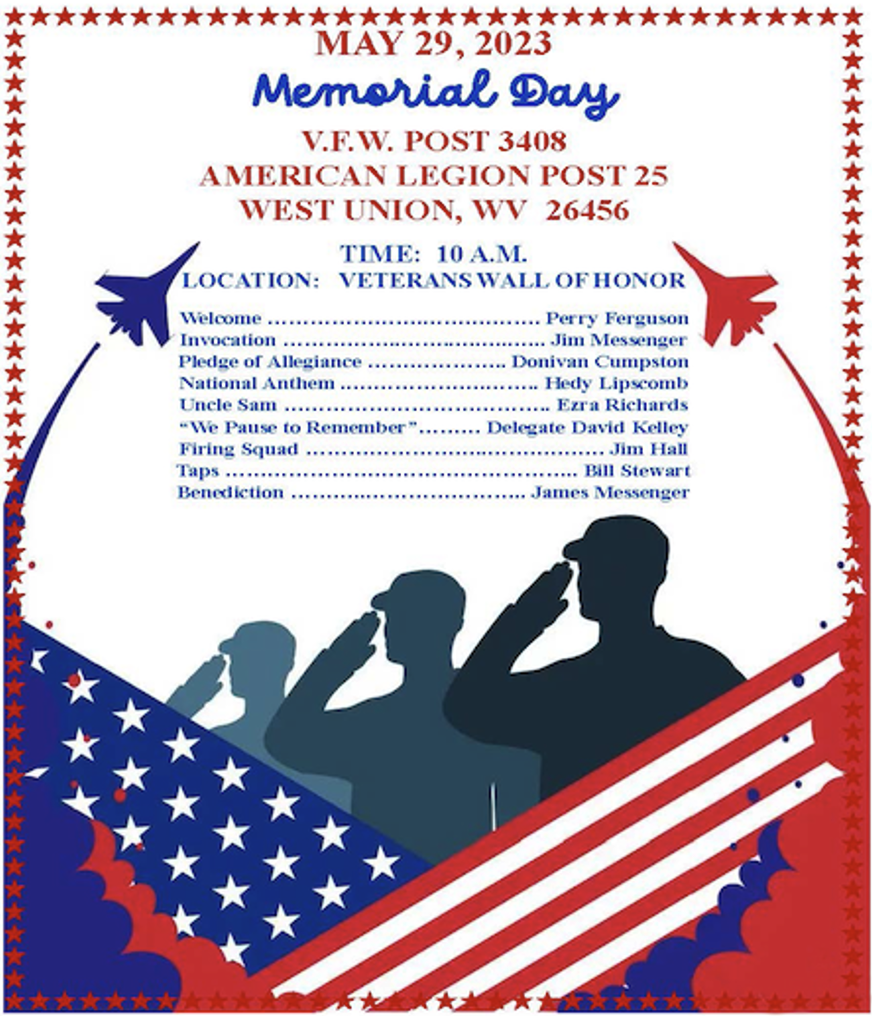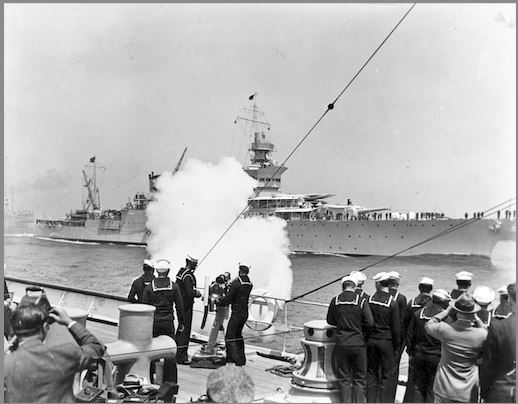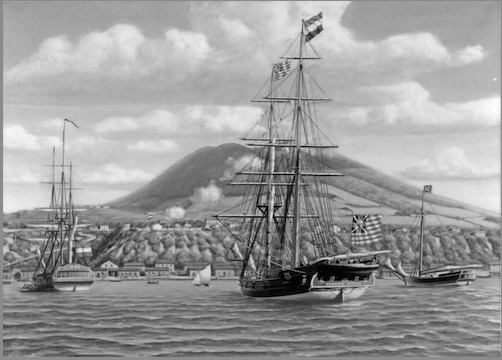


President Franklin D. Roosevelt, embarked on Indianapolis, where he received a 21-gun salute from Coast Guard Cutter Mojave during the presidential fleet review off Ambrose Light, New York, 31 May 1934.
Origins of
The 21-Gun Salute
As part of our series focused on Veterans this month, in honor of Memorial Day, formerly called Decoration Day, I chose to research the origins of the highest honor that can be given, the 21-Gun Salute.
You might be surprised to learn that gun salutes have been practiced for centuries throughout the world. That’s right, it is not just an American thing, or even something practiced solely in the Western Hemisphere. For, as far back as the 14th century, it was a common practice for ships to fire their cannons when entering a harbor that was friendly toward them to demonstrate that their cannons were empty and assure the friendly harbor that there was no ill intent. The guns at the harbor would reciprocate the practice, demonstrating their lack of ill intent.
Throughout history, there have been several incidences when the number of gun salutes varied. For example, in November of 1776 during the American Revolution, the Continental Navy brigantine, Andrew Doria, was fired by order of Captain Isaiah Robinson using a 13-Gun Salute when he entered the harbor of St. Eustatius in the West Indies. A few minutes later, the salute was returned with a 9-Gun Salute by order of the Dutch governor. At the time, a 13-gun salute would have represented the 13 colonies of the newly formed United States. The customary salute rendered to a republic at that time was 9 guns. This is often referred to as the “First Salute” to the American flag.

Continental Grand Union Navy brigantine, Andrew Doria.
In 1778, the first official salute by a foreign nation to the American Flag was when the Continental Navy ship Ranger, commanded by Captain John Paul Jones, fired a 13 Gun Salute and received a 9-Gun Salute in return from the French fleet anchored in Quiberon Bay, France.
In 1810, the practice of firing one gun for every state was officially authorized by the U.S. Department of War. At that time there were only 17 states in the Union. As the number of states grew, it became necessary to limit the number, and in 1841, the number was reduced from 26 to 21.
In 1818, U.S. Navy Regulations required for the first time that when the U.S. President visited a ship of the United States Navy, he was to be saluted with “21 guns.” Could this be because there were 21 states in the Union at that time? Let’s look at the timeline to see… On December 3, 1818, the state of Illinois was admitted to statehood, having been formed from part of the Illinois Territory. It was the 21st state in our great country.
The 21-Gun Salute was established as the international salute on August 18, 1875, when the United States and Great Britain announced an agreement to return salutes “gun for gun,” with the 21-gun salute as the highest national honor.
You may have noticed that the number of volleys fired was always odd numbers such as 7, 9, 11, 21. The reason for this is thought to be likely because of ancient superstitions that uneven numbers are lucky. As early as 1685, the firing of an even number of guns in salute was taken as indicating that a ship’s captain, master, or master gunner had died on a voyage.
Today, the U.S. Navy requires that the 21-Gun Salute is fired at noon for notable occasions, including Independence Day, Memorial Day, the Birthday of the sitting President, and President George Washington’s birthday. It is also fired at noon on the day of the funeral of a President, ex-President, or President-elect.
However, in the event of the funeral of other high-ranking officials such as the Secretary of Defense, Chairman of the Joint Chiefs of Staff, and military officers in command over multiple branches, a “19-Gun Salute” is given.
As for the military funerals of our Veterans, it is most practiced that Veterans get three volleys at most cemetery funerals. The three volleys are said to represent three words: Duty, honor, and country. This is followed by the “Last Call” whereby TAPS (a bugle call) is sounded to signal the end of a military funeral. Family members of the deceased Veteran will find three of the fired cartridges inside the carefully folded flag. The cartridges signify “duty, honor, and sacrifice.”
If you ever wondered what the words to this well-known bugle call are, I must tell you that the bugle call is not a song. It is a signal and there are no official lyrics for it. However, the most common is the first stanza to the most popular one below:
Day is done, gone the sun,
From the hills, from the lake, from the skies.
All is well, safely rest, God is nigh.
Go to sleep, peaceful sleep, May the soldier
or sailor, God keep. On the land or the deep, Safe in sleep.
Love, good night, must thou go,
when the day and the night need thee so?
All is well. Speedeth all to their rest.
Fades the light;
And afar Goeth day,
And the stars Shineth bright,
Fare thee well;
Day has gone, night is on.
Thanks, and praise, for our days,
‘Neath the sun, Neath the stars, ‘Neath the sky,
As we go, this we know, God is nigh.

Music and Lyrics to Taps
During the course of my research, I learned that according to the Department of Veteran Affairs, although it is common to call the practice the “21-gun salute,” it is the wrong wording for the salute used in military funerals. The Arlington National Cemetery calls the military salute a “three-volley salute” or a “three-rifle volley.” However, the long-standing calling of the 21-Gun Salute will no doubt be the term used by most civilians who are not involved in the military. It is worth noting that for the most part, most salutes today use rifles— M14, M1903, and the M1 Garand. Most often seven members fire three shots each, making up a total of twenty-one shots.
The American Legion says that a three-rifle volley “consists of no less than three and no more than seven rifles firing three volleys in memory of the fallen.” A “21-gun salute” uses a battery or artillery pieces instead of rifles and is reserved for heads of state, like the president or a former president.
By most accounts, it is said that the practice of the “3-rifle salute” stems from an old 17th to 18th-century custom of halting fighting on battlefields to remove the dead. Once removed, three volleys were given to signal the battle could resume. There are different interpretations of this custom, however, this is the most accepted account. I’ll leave it to you to do your own research.
Sources:
HQs, Military District of Washington, Fact Sheet: Gun Salutes, May 1969; Title 10, U. S. Code Armed Forces, (As amended through Jan. 7, 2011, Vol. III; U. S. Army Center of Military History; Marine Corps University
God Bless
Patricia Richards Harris, President
Doddridge County Historical Society
